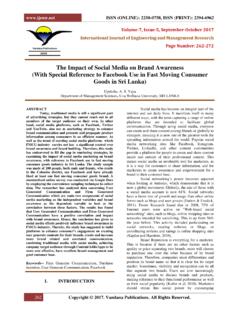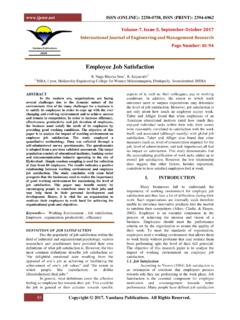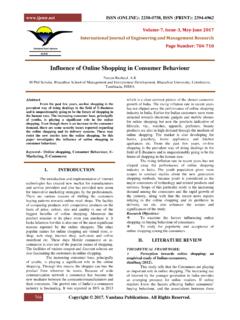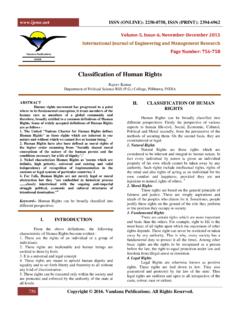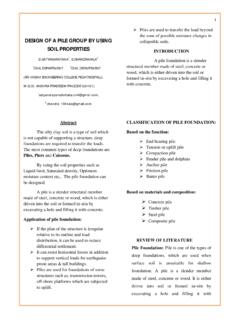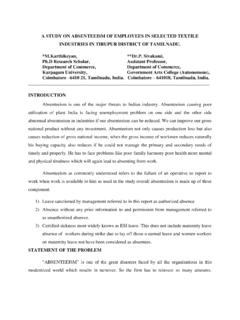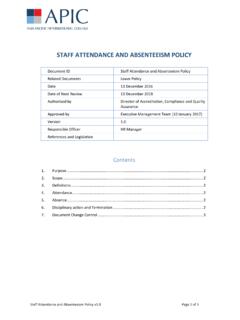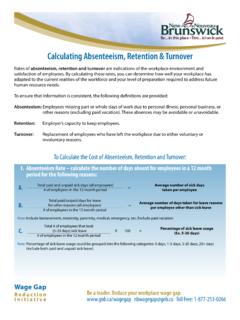Transcription of EMPLOYEES ABSENTEEISM: BARRIER FOR - IJEMR
1 88 Volume-3, Issue-6, December-2013, ISSN No.: 2250-0758 International Journal of Engineering and Management Research Available at: Page Number: 88-92 EMPLOYEES absenteeism : BARRIER for Retail Sector Organization Success Barkha Gupta (UGC-NET/ MBA-HR/ PGDCA/ B Sc. (Microbiology)) Asst. Professor, M K Ponda College of Business and Management, Bhopal, Madhya Pradesh, INDIA ABSTRACT absenteeism is the term generally used to refer to unscheduled employee absences from the workplace. It is a habitual pattern of absence from a duty or obligation. absenteeism is a big BARRIER for any kind of organization because its effect on organization growth.
2 As we all know that human resource is an important part of organization and without them we can t imagine the organization. absenteeism means employee absent for the duty due to reason of sickness, social functions, death of relatives etc. absenteeism of EMPLOYEES is normal but when ratio increase that directly effect on organization performance and also increase the cost and workload in organization. Absence control can often be an important step in the process of reducing business costs. Because of competitive pressures, companies can no longer afford to carry unnecessary absence that they may have tolerated in the past.
3 Therefore, many companies are focusing on the issue of eliminating, or at least reducing, unnecessary levels of absence. This research paper show the how absenteeism is a big BARRIER for retail sector organization and how its give the inverse effect on organization growth and development. Keywords absenteeism , EMPLOYEES absenteeism , Absence of EMPLOYEES , Organization success and absenteeism I. INTRODUCTION Every organization success depends on its valuable assets EMPLOYEES . So employee s absenteeism is a major BARRIER for organization success. absenteeism can be termed as an illness which may affect the internal structure of the organization, thus causing harm to the production process.
4 So there is a need to control the situation, by taking a thorough and in-detail analysis to identify the critical reasons of absenteeism , which will help to create a proper Organizational Culture. While employers expect workers to miss a certain number of workdays each year, excessive absences can equate to decreased productivity and can have a major effect on company finances, morale and other factors. Retail sector is grown concept in today scenario we know that number of EMPLOYEES in the Retail industry skew much younger than other industries. absenteeism is a BARRIER for retail sector growth.
5 II. DEFINETION There is no universal or standard definition surrounding workplace absenteeism . EMPLOYEES missing part or whole days of work due to personal illness, personal business, or other reasons (excluding paid vacation). These absences may be avoidable or unavoidable. According to French Man, Absence occurs whenever a person chooses to allocate time to activities that compete with scheduled work either to satisfy the waxing and warning of underlying motivational rhythms. absenteeism is a pattern in which an employee is habitually absent from work. Chronic absenteeism is often an indicator of poor employee performanceAbsenteeism can be defined as Failure of EMPLOYEES to report for work when they are schedule to work.
6 , a medical condition, or psychological problems. According to Martocchio & Harrison, Lack of an individual physical presence at given location and time when there is a social expectation for him or her to be there According to Gibbons, 1966: Johns/1978: Jones, 1971, he non-attendance of EMPLOYEES for scheduled work, it distinguishes absenteeism from other forms of non-attendance that are arranged in advanced and specifically avoids judgments of legitimacy associated with absent events that are implied by as sick leave III. OBJECTICE OF STUDY 1. To identify the reason of absenteeism .
7 2. To measure the EMPLOYEES absenteeism level. 89 3. To identify step required to decrease the absenteeism 4. To know the causes and effects of employee absenteeism . 5. To know about the absence management technique. IV. LITERATURE REVIEW RETAIL SECTOR Retail is the sale of goods and services from individuals or businesses to the end-user. Retailers are part of an integrated system called the supply chain. The India Retail Industry is the largest among all the industries. Retailing in India is one of the pillars of its economy. 4. 2 EMPLOYEES absenteeism - absenteeism is traditionally defined as a specific employee s unavailability for work, when work is actually available for this specific employee .
8 absenteeism can fall under 3 broad categories: legal (such as public holidays), authorized (such as approved holidays) and unauthorized (also referred to as casual absence). Unauthorized MANAGING absenteeism Absence measurement is essential in order for is what most organizations strive to avoid and keep to a minimum. management to compare between individual absences and departmental absences. Measuring absence is critical to identify the different patterns of employee absence and target the variables affecting it. Employers are entitled to expect regular ongoing attendance from their EMPLOYEES .
9 Poor attendance on the part of an employee is one of the most difficult problems an employer will be required to manage in the context of the employment relationship. There are essentially two kinds of absences: culpable and innocent/non-culpable. Regardless of whether an employee 's absences are culpable or innocent, it is important to have a proactive program in place for addressing and managing absenteeism . V. EMPLOYEES absenteeism & PRODUCTIVITY OF RETAIL SECTOR ORGANIZATION As we all know that every organization want less cost and more profit. Every organization invest cost on their EMPLOYEES so they provide revenue to the organization on revert but absenteeism is a BARRIER that give invert effect on productivity of retail sector.
10 Every employee has maintain a hierarchy and individual have its own responsibility in organization so absenteeism of EMPLOYEES is the hurdle on this hierarchy and gave the negative impact on productivity. absenteeism is an especially difficult problem to tackle, because there are both legitimate and poor excuses for missing work and it can be challenging for employers to effectively monitor, control and reduce absenteeism and increase productivity. VI. CAUSES OF absenteeism IN RETAIL SECTOR CALCULATION OF absenteeism RATE: absenteeism can be calculated for different EMPLOYEES and for different time periods like month and year.
